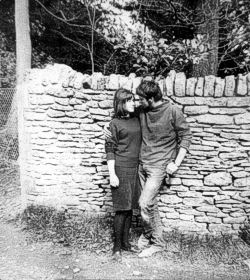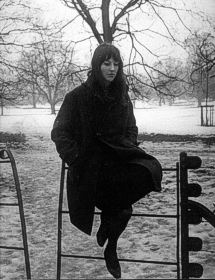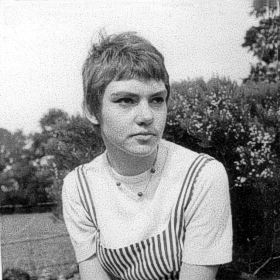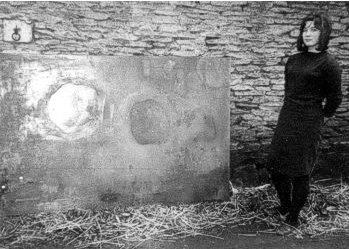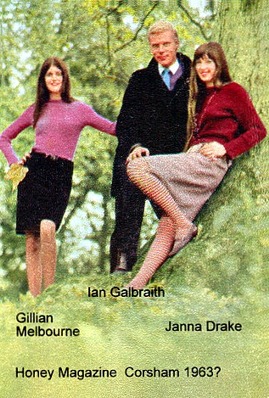I was educated at Dartington Hall School, arguably the most progressive co-educational school in
Britain in the 1950's. In my teens a husband and wife were appointed as joint 'Heads'. They were very autocratic which caused resentment in staff and pupils. I had problems with these new 'Heads', not least because they expelled several friends, including my girl friend. After my O' Levels I was advised to leave as I'd "out grown the school". I mention this as history repeated itself at
Corsham.
Fortunately I was accepted on the Foundation Course at Dartington College of Arts; who's staff were mainly Corsham trained. Corshams Diploma Course seemed more varied and less restricted than other Colleges who offered only the 4 year NDD Course, with intermediate and final exams. I applied to
Corsham, interviewed by
Clifford Ellis and accepted.
Having been raised at Dartington, Corsham Court didn't seem out of the ordinary, apart from the peacocks. Once at Corsham I found it wasn't as easy going as Dartington College of Arts. Apparently in the past Corsham had gained a reputation for loose living, and the authorities had insisted things were tightened up.
Most of the female students lived three miles out of town at Monks Park, in huts, inside a high fenced compound, like prisoners of war. We found it amusing that all new students were required to bring a toolkit which included wire cutters. The male students lived at Beechfield House, on the other side of the town, either in the House or in huts like an army camp. Initially I shared a room in the House. It was slightly easier for the men in the huts to have female visitors. If women were found in our rooms at anytime we were likely to be expelled. I think Corshams enforced segregation of the sexes only served to increase
our interest in the opposite sex.
We worked long hours, including Saturday mornings. To keep us out of the pubs and each others arms the Ellises introduced
compulsory evening classes, known as 8 to 10's. First Year students were set Design Projects at the start of the week, to be completed for presentation to staff and students the following week. The painter
Robyn Denny was in charge. He turned up each week dressed like one of his paintings, striped tie, shirt, trousers, jacket and socks. he never managed to find striped shoes. Completing these projects on time meant working weekends, evenings and sometimes all night. It was
surprising we had time to form romantic attachments. After a particularly
gruelling Design Project my girlfriend Diana Dean and I collapsed in Beechfields Common Room. I fell asleep; awakening, with a painful love bite on my neck, to find Diana had let me sleep through supper at the Court. Having no money for food resulted in a row and Diana and I going our
separate ways.
I borrowed money, went to the pub and met Rosemary Knight, a 2nd year NDD student considered cold by those tutors and older students who'd tried unsuccessfully to get her into bed. Rosemary going with a First Year made her even more unpopular. At the end of the year students were awarded prizes by their peers. One of the prizes I was awarded was a tin of Drinking Chocolate bearing the slogan 'Hot Chocolate for a Cold Night'.
Vicky Fields boyfriend Terry Pope was awarded a military medal inscribed 'For Valour in the Field'.
Rosemary spent most of the summer term sunbathing by the pool, but easily passed her intermediate exam. Having ability but being lazy and unpopular with tutors resulted in the Ellises kicking her out. Rosemary completed her NDD at
Birmingham College of Art. During the summer holiday I stayed with a College friend near Coventry and worked for his fathers building firm, so I could spend time with Rosemary. At the start of second year Rosemary and I commuted between Coventry and Corsham each weekend, but our long distance relationship didn't last till Christmas.
I had other problems in second year. At the end of my first year, 20 of my 'sculptural' pots were included in the Summer Exhibition; an unusual honour for a first year student. At the start of the summer holiday Clifford Ellis wrote to me saying my 'pots' were artistically good but technically bad. Followed at the end of the holiday by a letter saying my 'pots' were artistically bad but technically good. Cliffords letters made no sense at the time. I had enjoyed pottery with
John Colbeck, but the Head James Tower seemed hostile to me. Apparently he thought I was copying his work. After John explained to him I'd been trained at Dartington by one of Jameses ex-students Jameses attitude to me seemed less hostile. Thinking about this decades later perhaps I was mistaken. At the start of second year I was sent to the Extra Mural Department in Bath to do pottery with
John Eaves. In reality I was on my own. I was also required to study photography with
Rosemary Ellis. I think the idea was to teach me discipline. I asked to transfer to Sculpture from pottery but my request was denied.
I did my Teaching Practice at two huge Comprehensives in Bristol. I volunteered to teach 5 days a week instead of the normal 4. This meant I could avoid the Friday post mortem with Rosemary
Ellis. Despite a successful Teaching Practice I was one of several students selected for possible
expulsion. I was interviewed with my work by the external examiner
William Scott. He liked what I was doing and said I should be left alone to carry on. I was finally allowed to transfer to the Sculpture Department.
Painting was my main subject, and what sustained me through the Course. In my first two years my tutors were:-
Bill Crozier, Henry Mundy, Gillian Ayres,
Gwyther Irwin and Adrian Heath. I enjoyed working with all of them. At the start of 3rd year
Malcolm Hughes became my painting tutor. After my reprieve by William
Scott, Malcolm told me,
"they are out to get you, so you are going to cover the three year painting course in one year, so they can't find any excuse to fail
you". I worked in my room, with Malcolm visiting regularly. He helped me more than any other tutor. I remember him with great affection, as the most conscientious and hard working of all the staff I worked with.
There were 3 women students to every man at Corsham, this was great for the men. Some of the women had relationships with local men, and others got involved with the visiting tutors. It was said tutors would teach in London for convenience, Birmingham for the money, and Corsham for the girls. The Ellises were keen to keep students apart, but appeared to turn a blind eye to what tutors, married or single, got up to with female students. Three tutors,
Ray Burton, Jasper Jewett and Peter Stringer all married girls from my year, I don't think anyone was surprised when these 3 students were the only ones to graduate with 'Distinction'. About a 100 of us started first year and only about 25 graduated. Possibly we should all have been awarded a 'Distinction' for
surviving the Course.
Over coming the prohibition on sex was a challenge. Living in Beechfield House, under the watchful eye of the Warden meant one had to be resourceful, particularly in Winter. I discovered it was possible to break into the Life Studio at night, and make use of the models bed, which was kept warm all night by the electric fires, ready for the mornings life class. Probably the most unusual place I spent the night with a girlfriend was an
R.A.F. mobile tracking station in the middle of an airfield. The
most daring liason was in my second year when I attended the Christmas Show at Monks Park with
Janna Drake. We were seated directly in front of Clifford and Rosemary Ellis. When the lights went down, we slipped out into the compound and went to Jannas hut. Slipping back into our seats just as the lights came up at the end of the show. The Ellises seemed none the wiser. Emboldened, as the audience was leaving we slipped out into the compound and went back to Jannas hut.
My social circle were mainly NDD students, probably because 3 of my 4 girl friends were on the NDD Course. Girls doing NDD weren't guarded like those training to be teachers; they usually lived in digs or flats with the freedom to come and go as they pleased. My girl friend
Pam Coleman shared a granny flat with another girl, and a granny. The Landlords lived next door, they permitted male visitors but they weren't supposed to stay over night.
Traditionally the men of Beechfield and the women of Monks Park would mount 'raids' on each other. In 'A Celebration of Bath Academy of Art', by Derek Pope, I read accounts by two girls
on a 'raid' on Monks Park. I was really pleased they still remembered the 'raid' I had initiated. At dead of night a group of young Beechfield men went to Monks Park, took all the bikes from the sheds, removed the saddles, and hung the bikes in the trees. The saddles were then planted like mushrooms in the lawn. Apparently in the morning the women emerged to find the bike sheds blown over, and all of the bikes apparently blown into the trees. Taxis had to be called to get the women to their classes.
There was a good sense of cameraderie amongst the small band of Sculpture students. The Head
John Hoskin was affable in the pub, but in the Department he spent most of his time on his own work, monopolizing the welding equipment. The teaching was left to
Michael Pennie. The only materials we had to work with were plaster and clay. I taught myself to weld and wood
carve in the holidays.
At the end of 3rd year I wanted to continue my studies in Painting or Sculpture rather than teach straight away. John Hoskin suggested I speak to
Lydia Silvestri, an Italian Sculptress brought over by Clifford
Ellis. John said Lydia could arrange for me to work for Marino
Marini, and also gain experience in a Milan Foundry. Lydia agreed, and later told me she'd spoken to Clifford Ellis who'd promised financial help. Lydia had described me to Clifford but failed to give him my name. When I went to see Clifford he was furious; telling me I'd had a grant to become a teacher and so was morally obliged to teach. John Hoskin was in trouble for suggesting the idea, and angrily told me he'd stick his neck out for me if I was as talented as Diana Dean (my ex girlfriend). I knew Johns interest in Diana was not just professional, so I was more angry than hurt. Decades later I heard John had wanted to marry Diana. Lydia still agreed to make the arrangements, so I drove milk lorries all summer to raise the cash, and in September Pam Coleman and I set off for Lake Como where Lydia lived. She was expecting us, but on arrival I was told
Lydia and Clifford Ellis had left for England the previous day.
Back in Devon I took odd jobs until Isabelle Symons a tutor from Corsham contacted me about a teaching post at a Comprehensive in Oxford. I got the job. The salary after deductions was �40 per calendar month. I was too poor to socialize with the Oxford students. At weekends Pam either came to Oxford or I visited her in
Corsham.
The following year I was offered a Lecturing Post in Sculpture at Dartington College of Arts. A year or so later I took a bus load of my students to Corshams Summer Exhibition. John Hoskin greeted me warmly, saying.
"I always knew you'd do well".
After leaving Dartington I studied Bronze Casting at the R.C.A., quickly realizing it was not for me. I worked at the Serpentine Gallery in London. Became assistant to the Sculptor
Robert Adams, probably a more valuable experience than working for
Marini. I lived in Malaysia exhibiting with the British Council. Became Fellow in Sculpture at the University College of Wales. Then for many years taught Sculpture at Edinburgh College of Art.
My own work has always sustained me through out my life. In 1998 I took early retirement to devote more time to it. The balance of Painting and Sculpture has ebbed and flowed through my career; since retirement I mainly paint.
More
memories of student days at Corsham from 61 to 64
A Bath Spa Uni magazine had an article about a Dutch girl, called
Marianne who was an Art Student at Corsham from 1960 to 63. Reading her experiences prompted me to write more about my experiences at Corsham from 1961 to 64.
Clifford Ellis allowed Marianne to start her course a year early aged 17.
Theoretically she was on the 4 year National Diploma Course, with external exams after 2 and 4 years. Marianne completed her course in 3 years. She seems
to have been a private student studying subjects from the two different courses run at Corsham at the time. Marianne moved in different circles to the students I knew. She attended private parties at the Ellis flat, and was a personal friend of
Lord Methuen.
I found Clifford Ellis a remote autocrat, who communicated by letter, and I never saw in the Studio�s. A friend was enjoying working with
Stephen Russ on Fabric Design. Clifford cancelled the class, and told my friend Pottery was now his
second subject. My friend objected to doing Pottery. Clifford said it wasn�t his choice. My friend left Corsham studied Design at Birmingham, went on to the
Royal College, and a successful career as a Designer.
I learnt recently how a girl friend was removed from Corsham despite passing her intermediate National exams. During the summer holiday Clifford �phoned her father'. Telling him she was being �sent down�, but she would get a good reference for a College of her choice. Phoning the father of a 19 or 20 year old student was quite wrong, even in the 1960�s. I wonder for what reason Clifford wanted to get rid of this young
women.
After I was banished from the Pottery Department, I was sent to work with Rosemary Ellis in her Photography Department. She had a reputation with staff and
students for being tenacious and intimidating. I found her a bit tiresome, but capable of kindness.
Driving friends from Beechfield to Corsham Court my Mini Van was hit head on by a car travelling on my side of the road. My Mini having seat belts probably saved our lives.
Rosemary was first on the scene. Having only minor injuries she told me to drive her Land Rover to the �Court�, while she accompanied my injured passengers to Hospital in the Ambulance. I don�t remember driving to the �Court�. A passenger in the Land Rover told me later she�d been terrified as I drove the Land Rover like it was a Rally Car.
Next morning Rosemary instructed me to drive the College Bus around Beechfield Campus delivering furniture to the
studios. Obviously Rosemary believed if you fall off a horse you get straight back on. A kindness I�ve never forgotten.
In contrast to the kindness Rosemary showed me over the car crash. At the same time Rosemary and Clifford decided that some second year students should be interviewed by the External
Examiner.
The intention was that some of us would fail the Second Year Course before we�d even completed it. I think the External Examiner only failed one student. A friend who sustained broken ribs and a punctured kidney in the car crash.
So the Ellises had to wait until he was fully recovered before kicking him out.
After my banishment from Pottery, I attended Saturday morning Life Classes run by
James Tower head of Ceramics. James would set up the first pose, then leave. He asked me to run the class. Sometimes he returned at the end of the class, sometimes he didn�t. I can�t remember him ever looking at the students
drawings.
If they needed help they came to me. At the end of term James said to me
'I dislike students, but dislike you less than the others'.
Marianne mentions how amazed her group were when Howard Hodgkin started being nice to them. Howard is probably my favourite painter, but Howard being nice
to students does sound remarkable.
Teaching Practice was hard but rewarding work, and got me out of Corsham for two five week periods. The two Comprehensive Schools I taught at in Bristol were the largest outside London. The Art Departments great places, with friendly staff and excellent facilities. I only had one brush with authority.
Someone reported me to the Headmaster for teaching Pottery wearing a �Cardigan�. In fact it was the latest fashion. A Jacket without
Lapels as worn by The Beatles.
In general I had a free hand. Bristol Zoo lent me a Parrot for my painting classes. I asked the children to paint only what they could see of the
Parrot, and leave their paper blank where the bars of the cage were. The results were quite beautiful, and were retained for the College Collection.
I also borrowed a baby Crocodile. I told the children to be quiet and still, as noise and movement made the Crocodile act very aggressive, and if he got out
of his tank he was capable of biting a finger off. The resulting paintings were very animated.
As a student, a teacher and later a Lecturer I worked with many ex Corsham Graduates. After his death I discovered that my Art Teacher at school had studied at Corsham. After working for the French Resistance during the War. Others had War Service, or had done National Service. In the 50�s these mature students obviously enjoyed the freedom of an Art College. Corsham gained a reputation for being free and easy. A reputation Clifford tried to improve. One sanction he had at his disposal was that in the 50�s Corsham ran a two year Art Teaching Course. A 3rd year was awarded at Cliffords discretion.
I think it was more to do with control than security that by the 60�s the women�s Hostel at Monks Park resembled a Prisoner of War Camp.









